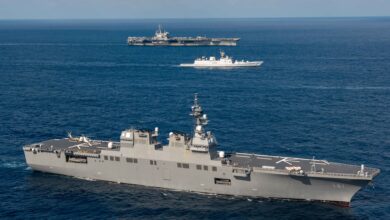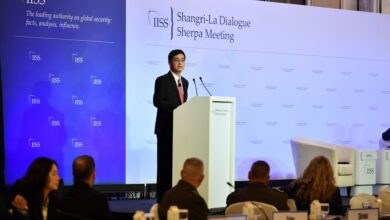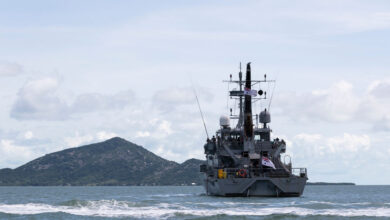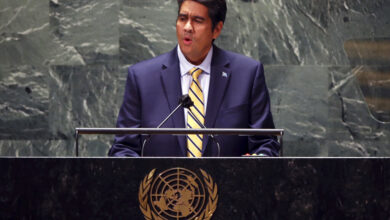Philippine leaders, public increasingly wary of Chinese takeover of territories

FORUM Staff
Philippine leaders are pushing to keep a major shipyard on Subic Bay under Philippine control after its current owner filed for bankruptcy and a court placed the facility into receivership. The prospect of a Chinese firm taking over the facility looms as a new threat to Philippine sovereignty, officials warned, because two Chinese firms, one controlled by the People’s Republic of China (PRC), have stated their interest, according to assorted news reports.
Philippine Defense Secretary Delfin Lorenzana said he had met with President Rodrigo Duterte, Sen. Richard Gordon and other officials in mid-January 2019 to plan how the Philippines can maintain control over the Subic Bay facility, known as the Philippine unit of Hanjin Heavy Industries and Construction Group, a South Korean company. The operator filed for bankruptcy earlier in January, according to BernarNews, an online news service affiliated with Radio Free Asia.
“The Philippine Navy suggested that ‘why not the Philippines take over, so that we’ll have a naval base there? Then we’ll have ship-building capabilities,’” Lorenzana said during an annual meeting of the Foreign Correspondents’ Association of the Philippines in Manila. Sen. Gordon recommended the Philippine Navy move its headquarters inside the shipyard, facing the South China Sea, BernarNews reported.
Manila seeks to buy more ships in the next decade and controlling the shipyard, built on the site of a former U.S. military base, would be advantageous, Lorenzana said. Manila is also considering offering the shipyard operations to entities in nations that are allies of the Philippines, such as Australia, Japan, South Korea and the United States, he said.
Various security experts have also raised alarm about a potential PRC takeover of the shipyard, which could help China seize control of the South China Sea, also known as the West Philippine Sea, given trends in PRC investment practices, according to the Maritime Executive website.
Former Philippine Navy chief Alexander Pama warned in a Facebook post about the threat posed by a Chinese firm gaining control of the assets.
“Let’s be aware that this Hanjin shipyard issue is not just about business, financial and other economic issues. This is a very significant national security issue,” he wrote, according to news reports. “The ownership of Hanjin shipyard in Subic Bay will give the owners unlimited access to one of our most strategic geographic naval and maritime assets. Although it is a commercial shipyard, nothing can prevent the owners from making it into a de-facto naval base.”
The Philippine public is also growing increasingly wary of China’s infiltration of the South China Sea, a recent survey found. Eighty-four percent of the population is opposed to the government’s inaction on China’s intrusion in claimed territories, according to a Social Weather Survey conducted in mid-September 2018 that entailed face-to-face interviews with 1,500 adults, age 18 and above and weighting with Philippine Statistics Authority projections.
Eighty-seven percent of the population say it is important that the Philippines regains control of islands occupied by China in the South China Sea, the survey found. Eighty-nine percent are aware of the South China Sea conflict, and 65 percent are aware of China’s abuses of Filipino fisherman, the survey said.
The Philippine people expressed “very good” trust for the United States, “moderate” for Japan, Malaysia and Israel, and “poor” for China, the survey found on the basis of a ratio of the percentage of respondents who reported high versus low levels of trust.
“The most critical external security challenge for the Philippines is the territorial and maritime claims in the South China Sea,” Lorenzana said, according to BernarNews.
“China, our big, next-door neighbor, has occupied and militarized some features closer to our shores,” the defense secretary said. “We have not, and we will not, surrender any part of our territory.”
After the end of the Cold War, Philippine nationalists secured the return of Subic to the Philippines in 1992 from the United States. Through a successful vote, a group of Philippine senators, known as the “Magnificent 12,” ended the U.S.’ long-term lease option. They included then-Senate President Jovito Salonga and Senators Juan Ponce Enrile, Agapito Aquino, Joseph Estrada, Teofisto Guingona Jr., Sotero Laurel, Orlando Mercado, Ernesto Maceda, Aquilino Pimentel Jr., Victor Ziga, Rene Saguisag and Wigberto Tanada, the rappler.com website reported.
The U.S. and Philippine administrations signed a subsequent defense cooperation agreement in 2014 providing for a rotational presence of U.S. troops on Philippine military bases, among other partnership efforts. The recent KAMANDAG 2 joint military exercise, which focused on developing counterterrorism and humanitarian assistance and disaster relief capabilities, exemplifies ongoing cooperation between the two militaries. The name is an acronym for Kaagapay ng mga Mandirigma ng Dagator Cooperation of Warriors of the Sea. (Pictured: U.S. and Philippines Marines land on the beach in assault amphibious vehicles during KAMANDAG 2 in Subic Bay in early October 2018.)




